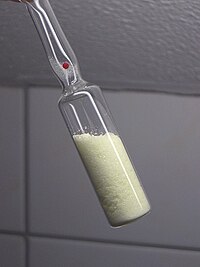
Photo from wikipedia
In view of their high lithium storage capability, phosphorus-based anodes are promising for lithium-ion batteries. However, the low reduction potential (0.74 V versus Li+ /Li) of the commonly used ethylene carbonate-based… Click to show full abstract
In view of their high lithium storage capability, phosphorus-based anodes are promising for lithium-ion batteries. However, the low reduction potential (0.74 V versus Li+ /Li) of the commonly used ethylene carbonate-based electrolyte does not allow the early formation of a solid electrolyte interphase (SEI) prior to the initial phosphorus alloying reaction (1.5 V versus Li+ /Li). In the absence of a protective SEI, the phosphorus anode develops cracks, creating additional P/electrolyte interfaces. This results in the loss of P and the formation of a discontinuous SEI, all of which greatly reduce the electrochemical performance of the anode. Here, the effect of solvent reduction potential on the structure of the SEI is investigated. It is found that solvents with a high reduction potential, such as fluoroethylene carbonate, decompose to form an SEI concomitantly with the P alloying reaction. This results in a continuous, mechanically robust, and Li3 PO4 -rich SEI with improved Li-ion conductivity. These attributes significantly improve the cyclic stability and rate performance of the phosphorus-based anode.
Journal Title: Small
Year Published: 2023
Link to full text (if available)
Share on Social Media: Sign Up to like & get
recommendations!